


Tibetan antelopes are on migration in Qiangtang National Nature Reserve in southwest China's Xizang Autonomous Region, June 15, 2024.
Tens of thousands of pregnant Tibetan antelopes start their migration around May every year for birth-giving and would return with their calves in late July. Their natural enemies including wolves and bears are always there to ambush them.
Under first-class state protection in China, the once-endangered Tibetan antelope is mostly found in the Xizang Autonomous Region, Qinghai Province, and the Xinjiang Uygur Autonomous Region. Their population has increased over the past three decades thanks to a ban on illegal hunting and measures implemented to improve their habitat. (Xinhua/Fei Maohua)

Tibetan antelopes are on migration in Qiangtang National Nature Reserve in southwest China's Xizang Autonomous Region, June 13, 2024.
Tens of thousands of pregnant Tibetan antelopes start their migration around May every year for birth-giving and would return with their calves in late July. Their natural enemies including wolves and bears are always there to ambush them.
Under first-class state protection in China, the once-endangered Tibetan antelope is mostly found in the Xizang Autonomous Region, Qinghai Province, and the Xinjiang Uygur Autonomous Region. Their population has increased over the past three decades thanks to a ban on illegal hunting and measures implemented to improve their habitat. (Xinhua/Fei Maohua)
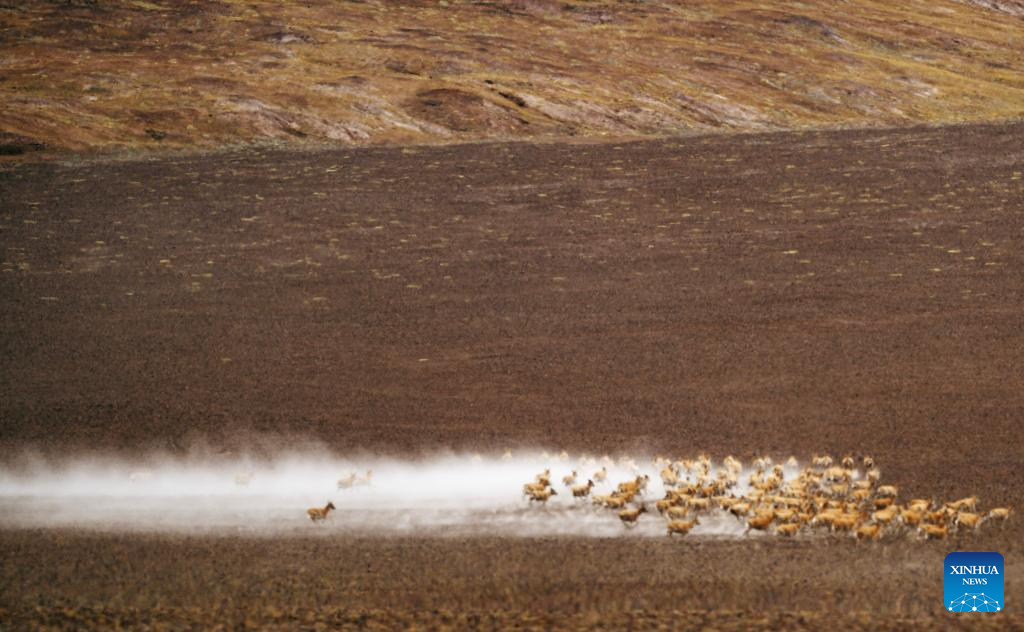
Tibetan antelopes are on migration in Qiangtang National Nature Reserve in southwest China's Xizang Autonomous Region, June 13, 2024.
Tens of thousands of pregnant Tibetan antelopes start their migration around May every year for birth-giving and would return with their calves in late July. Their natural enemies including wolves and bears are always there to ambush them.
Under first-class state protection in China, the once-endangered Tibetan antelope is mostly found in the Xizang Autonomous Region, Qinghai Province, and the Xinjiang Uygur Autonomous Region. Their population has increased over the past three decades thanks to a ban on illegal hunting and measures implemented to improve their habitat. (Xinhua/Fei Maohua)
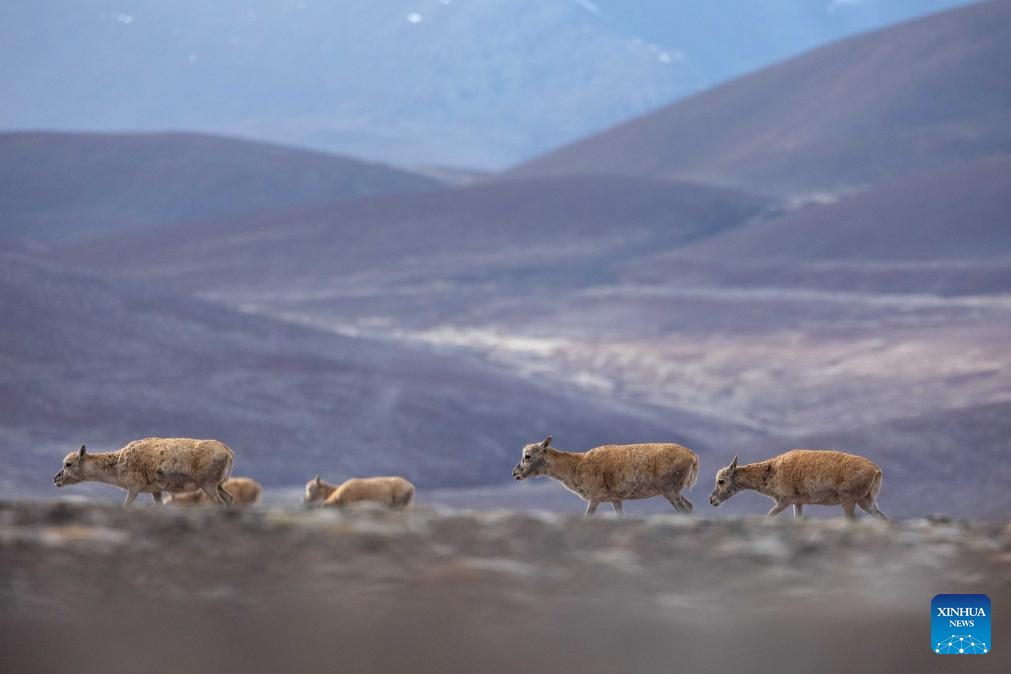
Tibetan antelopes are on migration in Qiangtang National Nature Reserve in southwest China's Xizang Autonomous Region, June 14, 2024.
Tens of thousands of pregnant Tibetan antelopes start their migration around May every year for birth-giving and would return with their calves in late July. Their natural enemies including wolves and bears are always there to ambush them.
Under first-class state protection in China, the once-endangered Tibetan antelope is mostly found in the Xizang Autonomous Region, Qinghai Province, and the Xinjiang Uygur Autonomous Region. Their population has increased over the past three decades thanks to a ban on illegal hunting and measures implemented to improve their habitat. (Xinhua/Tenzing Nima Qadhup)
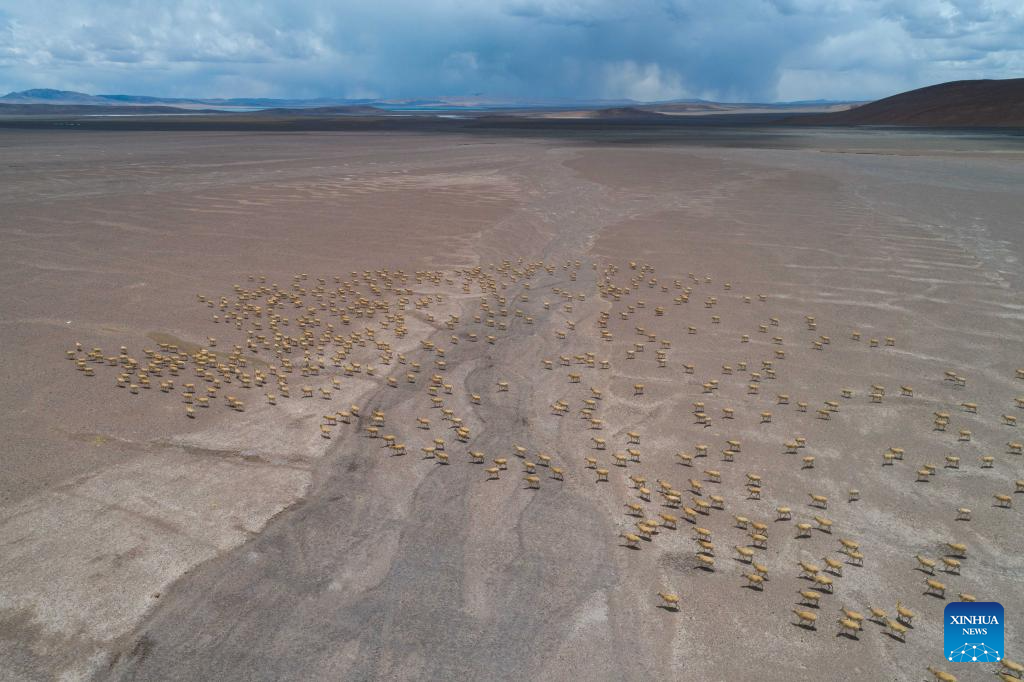
An aerial drone photo taken on June 13, 2024 shows Tibetan antelopes on migration in Qiangtang National Nature Reserve in southwest China's Xizang Autonomous Region.
Tens of thousands of pregnant Tibetan antelopes start their migration around May every year for birth-giving and would return with their calves in late July. Their natural enemies including wolves and bears are always there to ambush them.
Under first-class state protection in China, the once-endangered Tibetan antelope is mostly found in the Xizang Autonomous Region, Qinghai Province, and the Xinjiang Uygur Autonomous Region. Their population has increased over the past three decades thanks to a ban on illegal hunting and measures implemented to improve their habitat. (Xinhua/Tenzing Nima Qadhup)
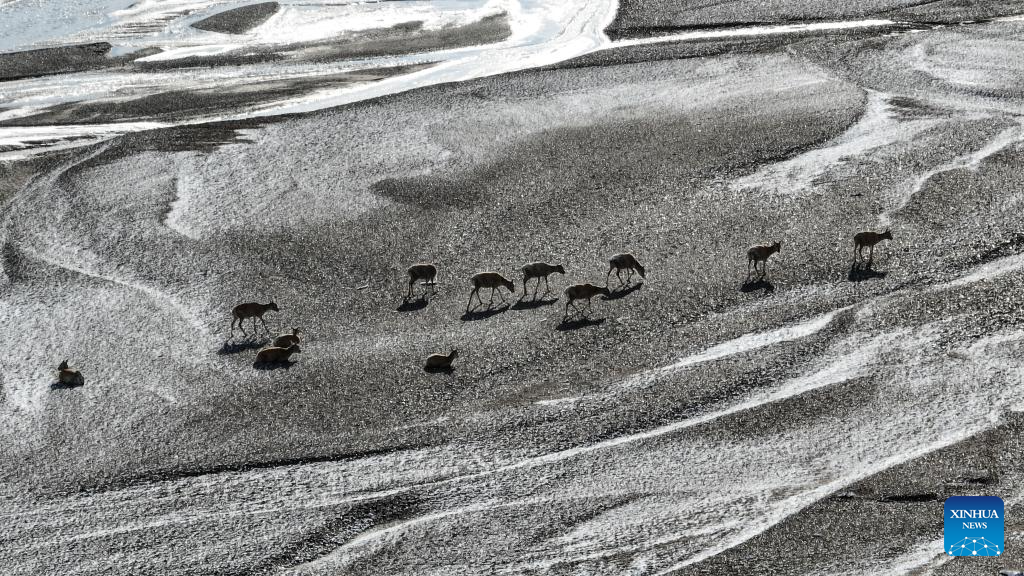
An aerial drone photo taken on June 15, 2024 shows Tibetan antelopes on migration to their birth-giving ground in Qiangtang National Nature Reserve in southwest China's Xizang Autonomous Region.
Tens of thousands of pregnant Tibetan antelopes start their migration around May every year for birth-giving and would return with their calves in late July. Their natural enemies including wolves and bears are always there to ambush them.
Under first-class state protection in China, the once-endangered Tibetan antelope is mostly found in the Xizang Autonomous Region, Qinghai Province, and the Xinjiang Uygur Autonomous Region. Their population has increased over the past three decades thanks to a ban on illegal hunting and measures implemented to improve their habitat. (Xinhua/Jigme Dorje)
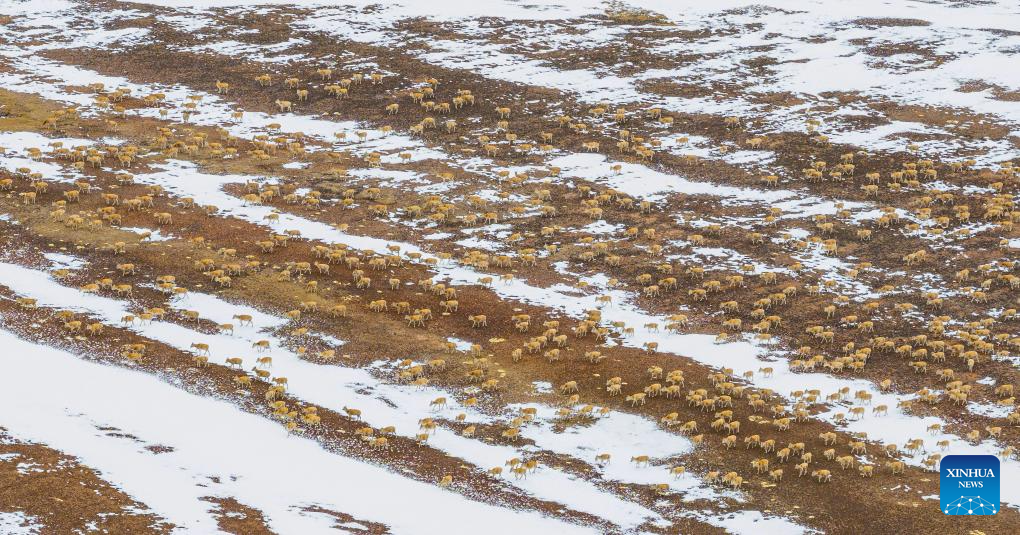
An aerial drone photo taken on May 9, 2024 shows Tibetan antelopes on migration to their birth-giving ground in Qiangtang National Nature Reserve in southwest China's Xizang Autonomous Region.
Tens of thousands of pregnant Tibetan antelopes start their migration around May every year for birth-giving and would return with their calves in late July. Their natural enemies including wolves and bears are always there to ambush them.
Under first-class state protection in China, the once-endangered Tibetan antelope is mostly found in the Xizang Autonomous Region, Qinghai Province, and the Xinjiang Uygur Autonomous Region. Their population has increased over the past three decades thanks to a ban on illegal hunting and measures implemented to improve their habitat. (Xinhua/Tenzin Nyida)

Male Tibetan antelopes guard the femle ones during their migration to their birth-giving ground in Qiangtang National Nature Reserve in southwest China's Xizang Autonomous Region, May 8, 2024.
Tens of thousands of pregnant Tibetan antelopes start their migration around May every year for birth-giving and would return with their calves in late July. Their natural enemies including wolves and bears are always there to ambush them.
Under first-class state protection in China, the once-endangered Tibetan antelope is mostly found in the Xizang Autonomous Region, Qinghai Province, and the Xinjiang Uygur Autonomous Region. Their population has increased over the past three decades thanks to a ban on illegal hunting and measures implemented to improve their habitat. (Xinhua/Jiang Fan)

An aerial drone photo taken on June 15, 2024 shows Tibetan antelopes on migration to their birth-giving ground in Qiangtang National Nature Reserve in southwest China's Xizang Autonomous Region.
Tens of thousands of pregnant Tibetan antelopes start their migration around May every year for birth-giving and would return with their calves in late July. Their natural enemies including wolves and bears are always there to ambush them.
Under first-class state protection in China, the once-endangered Tibetan antelope is mostly found in the Xizang Autonomous Region, Qinghai Province, and the Xinjiang Uygur Autonomous Region. Their population has increased over the past three decades thanks to a ban on illegal hunting and measures implemented to improve their habitat. (Xinhua/Jigme Dorje)
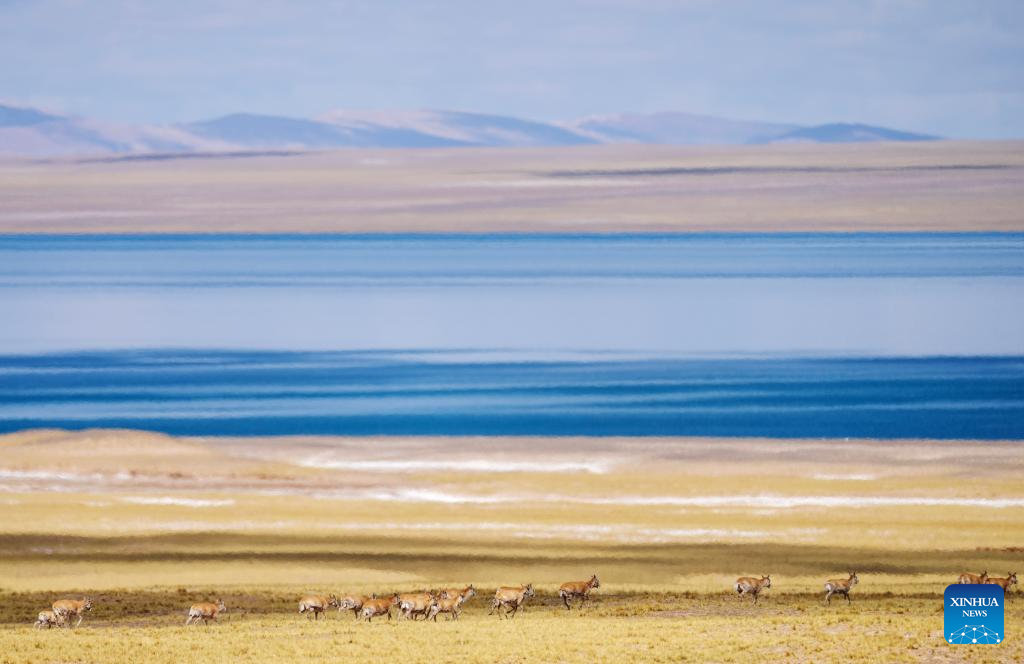
Tibetan antelopes are on migration in Qiangtang National Nature Reserve in southwest China's Xizang Autonomous Region, June 13, 2024.
Tens of thousands of pregnant Tibetan antelopes start their migration around May every year for birth-giving and would return with their calves in late July. Their natural enemies including wolves and bears are always there to ambush them.
Under first-class state protection in China, the once-endangered Tibetan antelope is mostly found in the Xizang Autonomous Region, Qinghai Province, and the Xinjiang Uygur Autonomous Region. Their population has increased over the past three decades thanks to a ban on illegal hunting and measures implemented to improve their habitat. (Xinhua/Fei Maohua)
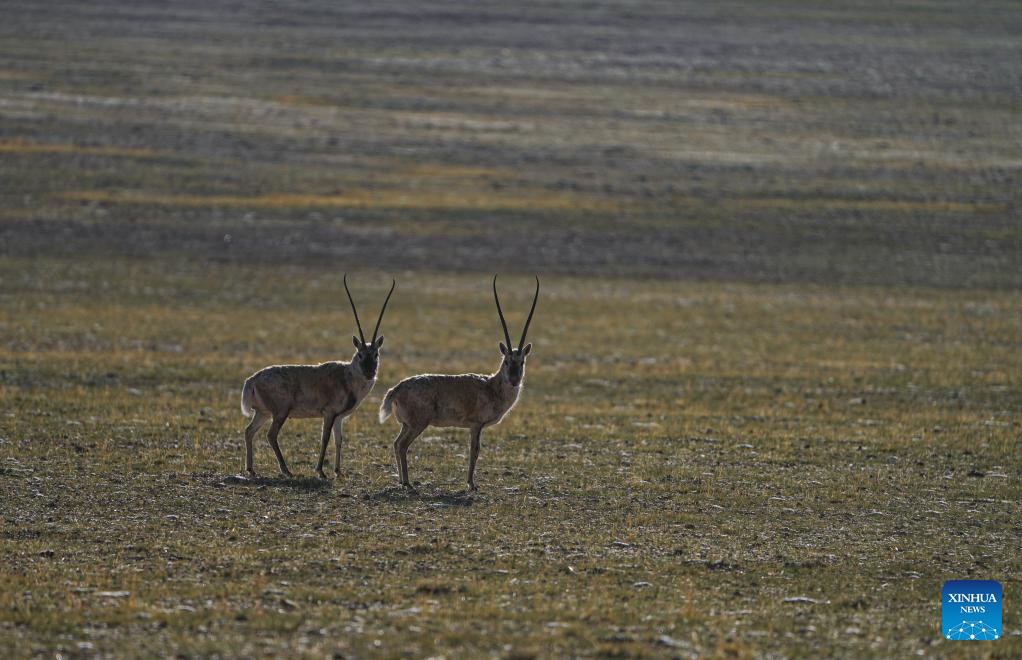
Male Tibetan antelopes guard the female ones during their migration to their birth-giving ground in Qiangtang National Nature Reserve in southwest China's Xizang Autonomous Region, June 13, 2024.
Tens of thousands of pregnant Tibetan antelopes start their migration around May every year for birth-giving and would return with their calves in late July. Their natural enemies including wolves and bears are always there to ambush them.
Under first-class state protection in China, the once-endangered Tibetan antelope is mostly found in the Xizang Autonomous Region, Qinghai Province, and the Xinjiang Uygur Autonomous Region. Their population has increased over the past three decades thanks to a ban on illegal hunting and measures implemented to improve their habitat. (Xinhua/Jigme Dorje)
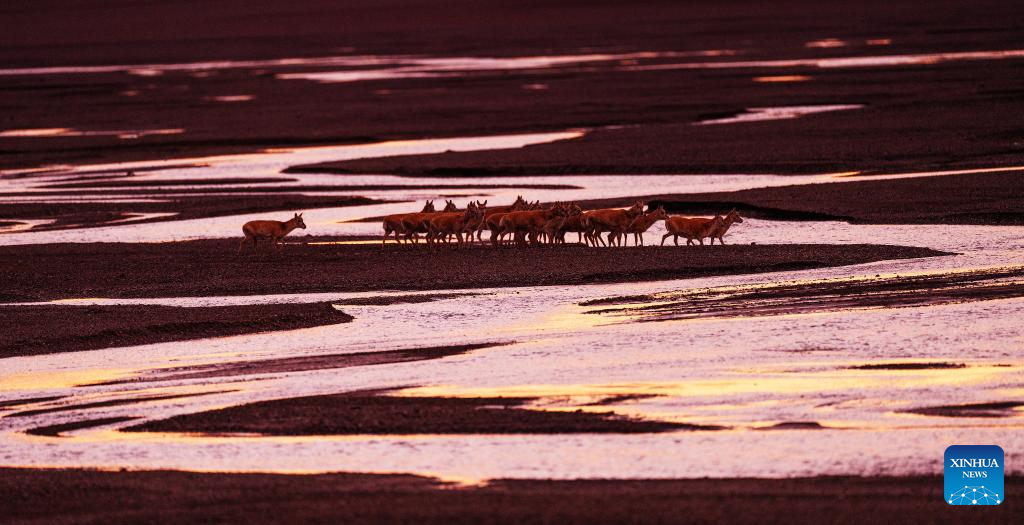
Female Tibetan antelopes are on migration to their birth-giving ground in Qiangtang National Nature Reserve in southwest China's Xizang Autonomous Region, June 13, 2024.
Tens of thousands of pregnant Tibetan antelopes start their migration around May every year for birth-giving and would return with their calves in late July. Their natural enemies including wolves and bears are always there to ambush them.
Under first-class state protection in China, the once-endangered Tibetan antelope is mostly found in the Xizang Autonomous Region, Qinghai Province, and the Xinjiang Uygur Autonomous Region. Their population has increased over the past three decades thanks to a ban on illegal hunting and measures implemented to improve their habitat. (Xinhua/Fei Maohua)
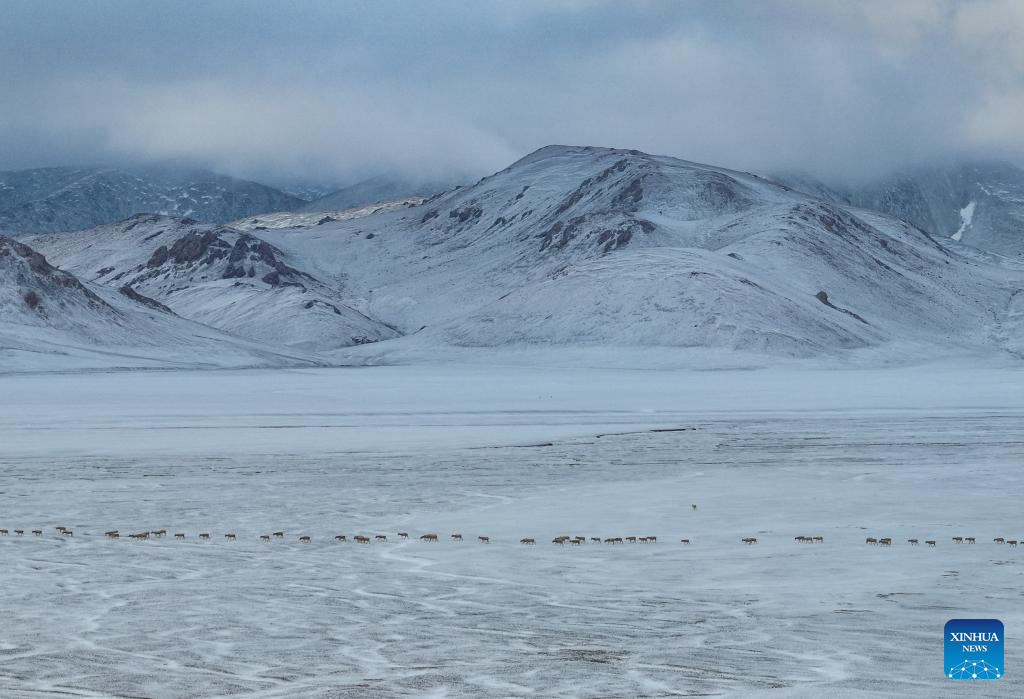
An aerial drone photo taken on June 15, 2024 shows Tibetan antelopes on migration to their birth-giving ground in Qiangtang National Nature Reserve in southwest China's Xizang Autonomous Region.
Tens of thousands of pregnant Tibetan antelopes start their migration around May every year for birth-giving and would return with their calves in late July. Their natural enemies including wolves and bears are always there to ambush them.
Under first-class state protection in China, the once-endangered Tibetan antelope is mostly found in the Xizang Autonomous Region, Qinghai Province, and the Xinjiang Uygur Autonomous Region. Their population has increased over the past three decades thanks to a ban on illegal hunting and measures implemented to improve their habitat. (Xinhua/Jigme Dorje)

A Tibetan antelope is pictured in Qiangtang National Nature Reserve in southwest China's Xizang Autonomous Region, June 13, 2024.
Tens of thousands of pregnant Tibetan antelopes start their migration around May every year for birth-giving and would return with their calves in late July. Their natural enemies including wolves and bears are always there to ambush them.
Under first-class state protection in China, the once-endangered Tibetan antelope is mostly found in the Xizang Autonomous Region, Qinghai Province, and the Xinjiang Uygur Autonomous Region. Their population has increased over the past three decades thanks to a ban on illegal hunting and measures implemented to improve their habitat. (Xinhua/Fei Maohua)

Tibetan antelopes are on migration in Qiangtang National Nature Reserve in southwest China's Xizang Autonomous Region, June 13, 2024.
Tens of thousands of pregnant Tibetan antelopes start their migration around May every year for birth-giving and would return with their calves in late July. Their natural enemies including wolves and bears are always there to ambush them.
Under first-class state protection in China, the once-endangered Tibetan antelope is mostly found in the Xizang Autonomous Region, Qinghai Province, and the Xinjiang Uygur Autonomous Region. Their population has increased over the past three decades thanks to a ban on illegal hunting and measures implemented to improve their habitat. (Xinhua/Fei Maohua)

A female Tibetan antelope is pictured in Qiangtang National Nature Reserve in southwest China's Xizang Autonomous Region, June 15, 2024.
Tens of thousands of pregnant Tibetan antelopes start their migration around May every year for birth-giving and would return with their calves in late July. Their natural enemies including wolves and bears are always there to ambush them.
Under first-class state protection in China, the once-endangered Tibetan antelope is mostly found in the Xizang Autonomous Region, Qinghai Province, and the Xinjiang Uygur Autonomous Region. Their population has increased over the past three decades thanks to a ban on illegal hunting and measures implemented to improve their habitat. (Xinhua/Fei Maohua)

An aerial drone photo taken on June 14, 2024 shows Tibetan antelopes on migration to their birth-giving ground in Qiangtang National Nature Reserve in southwest China's Xizang Autonomous Region.
Tens of thousands of pregnant Tibetan antelopes start their migration around May every year for birth-giving and would return with their calves in late July. Their natural enemies including wolves and bears are always there to ambush them.
Under first-class state protection in China, the once-endangered Tibetan antelope is mostly found in the Xizang Autonomous Region, Qinghai Province, and the Xinjiang Uygur Autonomous Region. Their population has increased over the past three decades thanks to a ban on illegal hunting and measures implemented to improve their habitat. (Xinhua/Purbu Tsering)
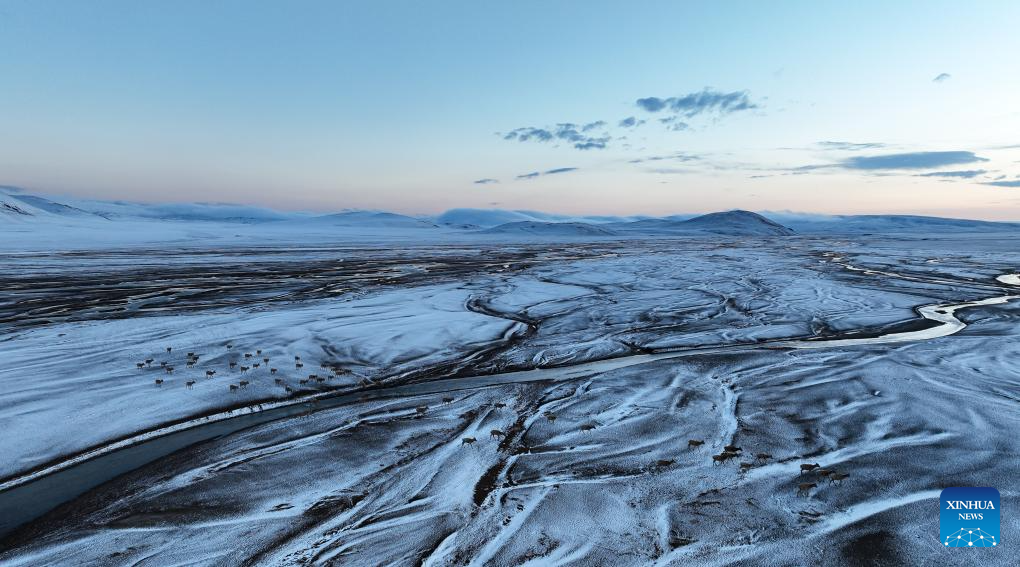
An aerial drone photo taken on June 14, 2024 shows Tibetan antelopes on migration to their birth-giving ground in Qiangtang National Nature Reserve in southwest China's Xizang Autonomous Region.
Tens of thousands of pregnant Tibetan antelopes start their migration around May every year for birth-giving and would return with their calves in late July. Their natural enemies including wolves and bears are always there to ambush them.
Under first-class state protection in China, the once-endangered Tibetan antelope is mostly found in the Xizang Autonomous Region, Qinghai Province, and the Xinjiang Uygur Autonomous Region. Their population has increased over the past three decades thanks to a ban on illegal hunting and measures implemented to improve their habitat. (Xinhua/Purbu Tsering)
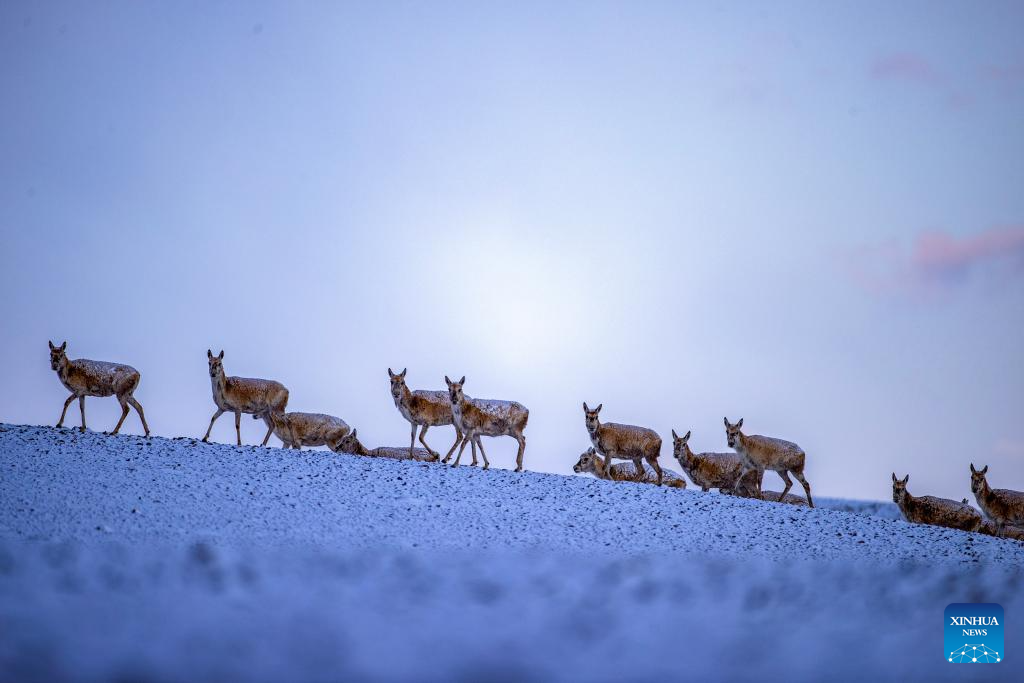
Female Tibetan antelopes are on migration to their birth-giving ground in Qiangtang National Nature Reserve in southwest China's Xizang Autonomous Region, June 15, 2024.
Tens of thousands of pregnant Tibetan antelopes start their migration around May every year for birth-giving and would return with their calves in late July. Their natural enemies including wolves and bears are always there to ambush them.
Under first-class state protection in China, the once-endangered Tibetan antelope is mostly found in the Xizang Autonomous Region, Qinghai Province, and the Xinjiang Uygur Autonomous Region. Their population has increased over the past three decades thanks to a ban on illegal hunting and measures implemented to improve their habitat. (Xinhua/Jiang Fan)
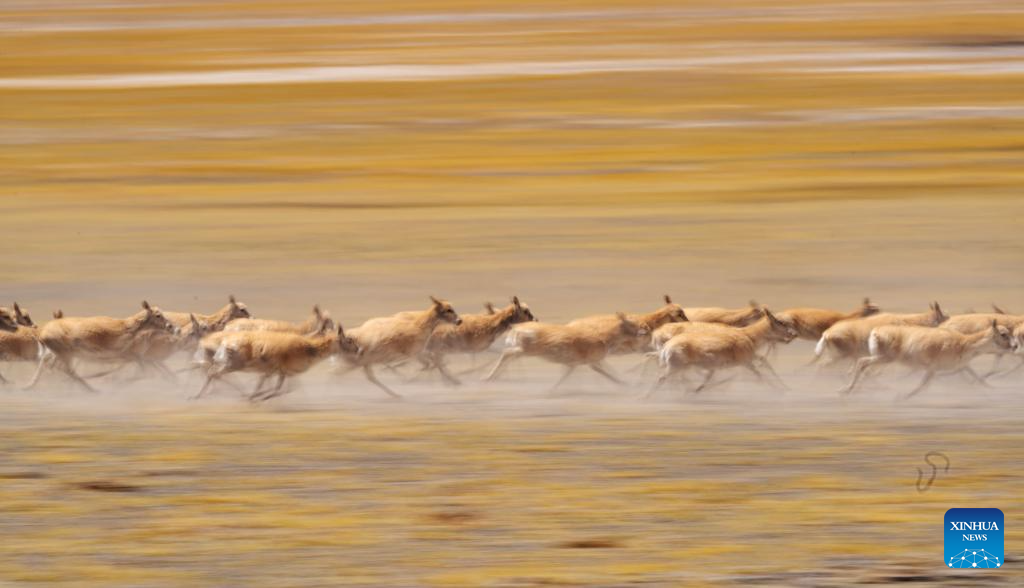
Tibetan antelopes gallop during their migration in Qiangtang National Nature Reserve in southwest China's Xizang Autonomous Region, June 13, 2024.
Tens of thousands of pregnant Tibetan antelopes start their migration around May every year for birth-giving and would return with their calves in late July. Their natural enemies including wolves and bears are always there to ambush them.
Under first-class state protection in China, the once-endangered Tibetan antelope is mostly found in the Xizang Autonomous Region, Qinghai Province, and the Xinjiang Uygur Autonomous Region. Their population has increased over the past three decades thanks to a ban on illegal hunting and measures implemented to improve their habitat. (Xinhua/Fei Maohua)
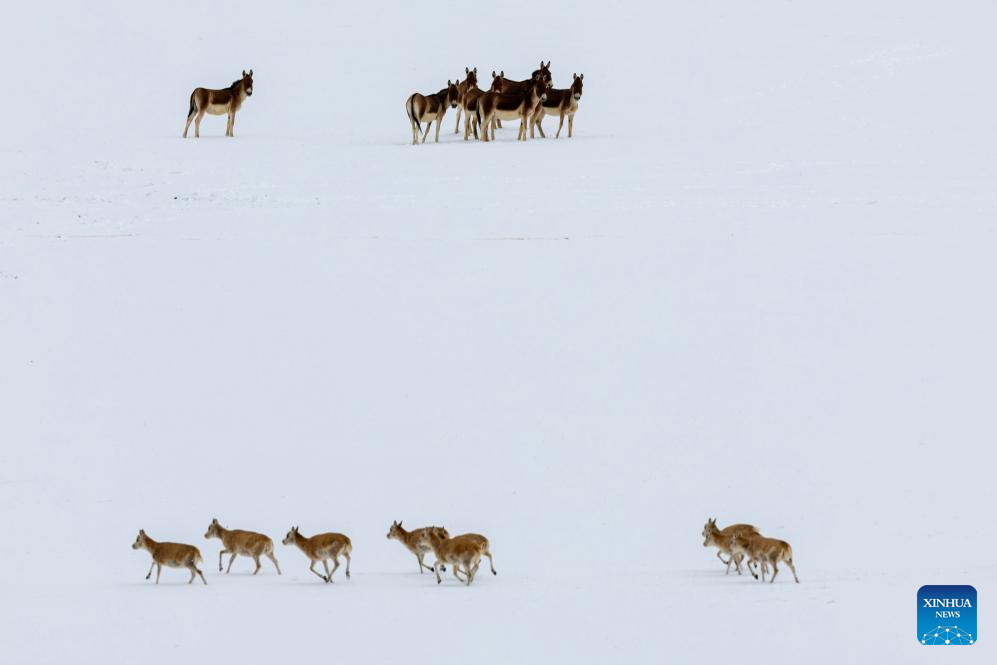
A herd of Tibetan wild donkeys watches Tibetan antelopes migrating in Qiangtang National Nature Reserve in southwest China's Xizang Autonomous Region, May 8, 2024.
Tens of thousands of pregnant Tibetan antelopes start their migration around May every year for birth-giving and would return with their calves in late July. Their natural enemies including wolves and bears are always there to ambush them.
Under first-class state protection in China, the once-endangered Tibetan antelope is mostly found in the Xizang Autonomous Region, Qinghai Province, and the Xinjiang Uygur Autonomous Region. Their population has increased over the past three decades thanks to a ban on illegal hunting and measures implemented to improve their habitat. (Xinhua/Jiang Fan)
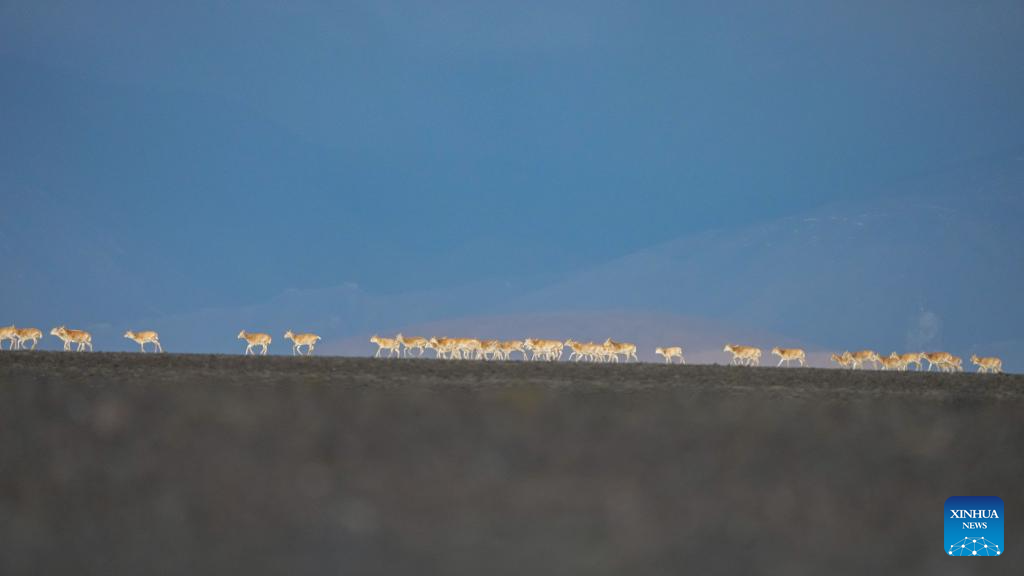
Tibetan antelopes are on migration in Qiangtang National Nature Reserve in southwest China's Xizang Autonomous Region, June 13, 2024.
Tens of thousands of pregnant Tibetan antelopes start their migration around May every year for birth-giving and would return with their calves in late July. Their natural enemies including wolves and bears are always there to ambush them.
Under first-class state protection in China, the once-endangered Tibetan antelope is mostly found in the Xizang Autonomous Region, Qinghai Province, and the Xinjiang Uygur Autonomous Region. Their population has increased over the past three decades thanks to a ban on illegal hunting and measures implemented to improve their habitat. (Xinhua/Jigme Dorje)
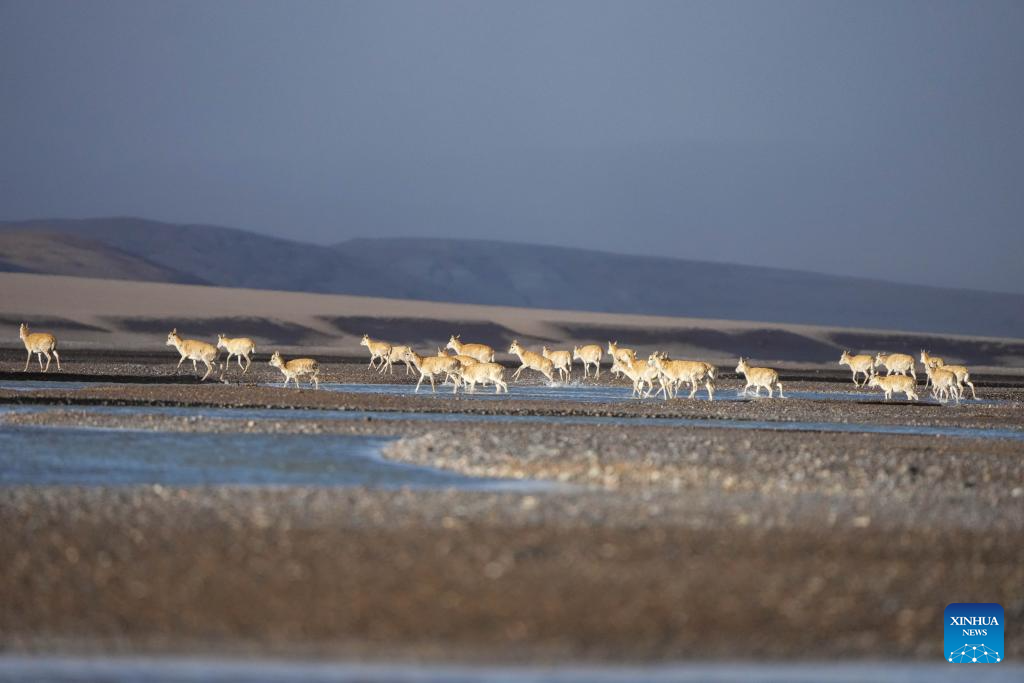
Tibetan antelopes are on migration in Qiangtang National Nature Reserve in southwest China's Xizang Autonomous Region, June 13, 2024.
Tens of thousands of pregnant Tibetan antelopes start their migration around May every year for birth-giving and would return with their calves in late July. Their natural enemies including wolves and bears are always there to ambush them.
Under first-class state protection in China, the once-endangered Tibetan antelope is mostly found in the Xizang Autonomous Region, Qinghai Province, and the Xinjiang Uygur Autonomous Region. Their population has increased over the past three decades thanks to a ban on illegal hunting and measures implemented to improve their habitat. (Xinhua/Jigme Dorje)
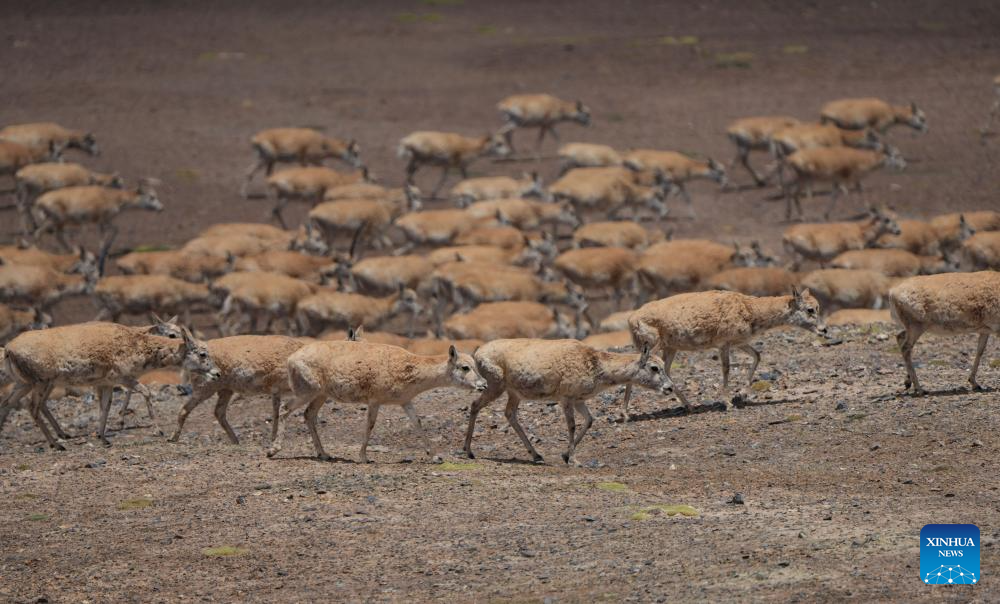
Tibetan antelopes are on migration in Qiangtang National Nature Reserve in southwest China's Xizang Autonomous Region, June 14, 2024.
Tens of thousands of pregnant Tibetan antelopes start their migration around May every year for birth-giving and would return with their calves in late July. Their natural enemies including wolves and bears are always there to ambush them.
Under first-class state protection in China, the once-endangered Tibetan antelope is mostly found in the Xizang Autonomous Region, Qinghai Province, and the Xinjiang Uygur Autonomous Region. Their population has increased over the past three decades thanks to a ban on illegal hunting and measures implemented to improve their habitat. (Xinhua/Jigme Dorje)
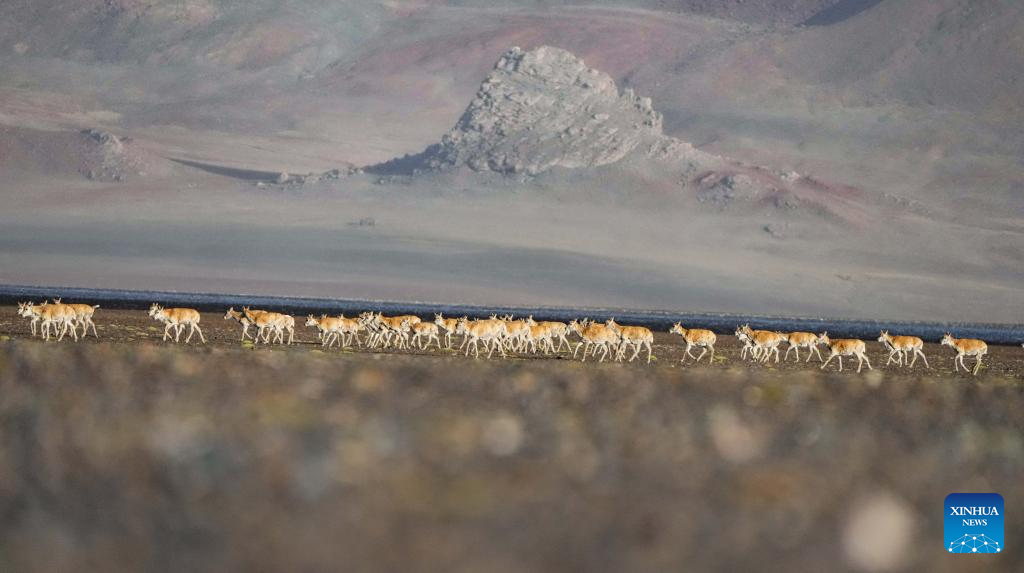
Tibetan antelopes are on migration in Qiangtang National Nature Reserve in southwest China's Xizang Autonomous Region, June 13, 2024.
Tens of thousands of pregnant Tibetan antelopes start their migration around May every year for birth-giving and would return with their calves in late July. Their natural enemies including wolves and bears are always there to ambush them.
Under first-class state protection in China, the once-endangered Tibetan antelope is mostly found in the Xizang Autonomous Region, Qinghai Province, and the Xinjiang Uygur Autonomous Region. Their population has increased over the past three decades thanks to a ban on illegal hunting and measures implemented to improve their habitat. (Xinhua/Jigme Dorje)

Male Tibetan antelopes guard the femle ones during their migration to their birth-giving ground in Qiangtang National Nature Reserve in southwest China's Xizang Autonomous Region, June 12, 2024.
Tens of thousands of pregnant Tibetan antelopes start their migration around May every year for birth-giving and would return with their calves in late July. Their natural enemies including wolves and bears are always there to ambush them.
Under first-class state protection in China, the once-endangered Tibetan antelope is mostly found in the Xizang Autonomous Region, Qinghai Province, and the Xinjiang Uygur Autonomous Region. Their population has increased over the past three decades thanks to a ban on illegal hunting and measures implemented to improve their habitat. (Xinhua/Tenzing Nima Qadhup)

Tibetan antelopes are on migration in Qiangtang National Nature Reserve in southwest China's Xizang Autonomous Region, June 13, 2024.
Tens of thousands of pregnant Tibetan antelopes start their migration around May every year for birth-giving and would return with their calves in late July. Their natural enemies including wolves and bears are always there to ambush them.
Under first-class state protection in China, the once-endangered Tibetan antelope is mostly found in the Xizang Autonomous Region, Qinghai Province, and the Xinjiang Uygur Autonomous Region. Their population has increased over the past three decades thanks to a ban on illegal hunting and measures implemented to improve their habitat. (Xinhua/Fei Maohua)
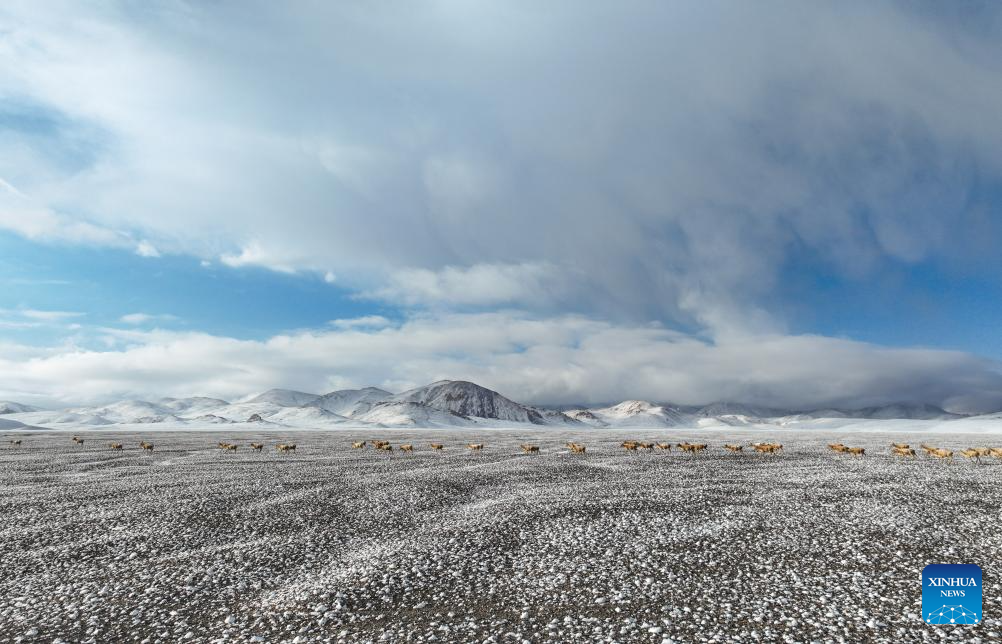
An aerial drone photo taken on June 15, 2024 shows Tibetan antelopes on migration to their birth-giving ground in Qiangtang National Nature Reserve in southwest China's Xizang Autonomous Region.
Tens of thousands of pregnant Tibetan antelopes start their migration around May every year for birth-giving and would return with their calves in late July. Their natural enemies including wolves and bears are always there to ambush them.
Under first-class state protection in China, the once-endangered Tibetan antelope is mostly found in the Xizang Autonomous Region, Qinghai Province, and the Xinjiang Uygur Autonomous Region. Their population has increased over the past three decades thanks to a ban on illegal hunting and measures implemented to improve their habitat. (Xinhua/Jigme Dorje)
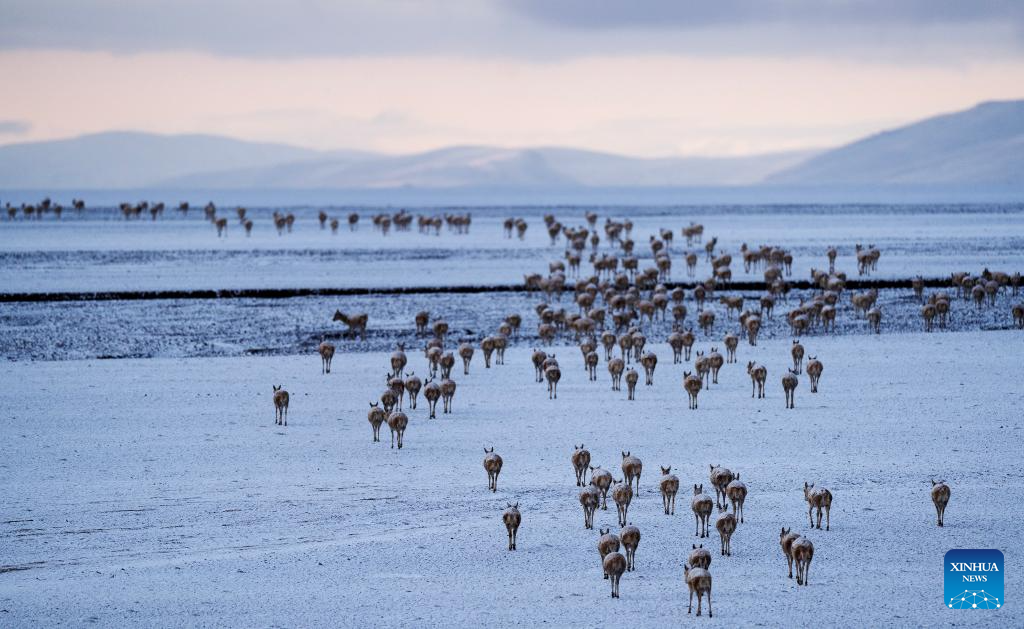
Female Tibetan antelopes are on migration to their birth-giving ground in Qiangtang National Nature Reserve in southwest China's Xizang Autonomous Region, June 15, 2024.
Tens of thousands of pregnant Tibetan antelopes start their migration around May every year for birth-giving and would return with their calves in late July. Their natural enemies including wolves and bears are always there to ambush them.
Under first-class state protection in China, the once-endangered Tibetan antelope is mostly found in the Xizang Autonomous Region, Qinghai Province, and the Xinjiang Uygur Autonomous Region. Their population has increased over the past three decades thanks to a ban on illegal hunting and measures implemented to improve their habitat. (Xinhua/Fei Maohua)
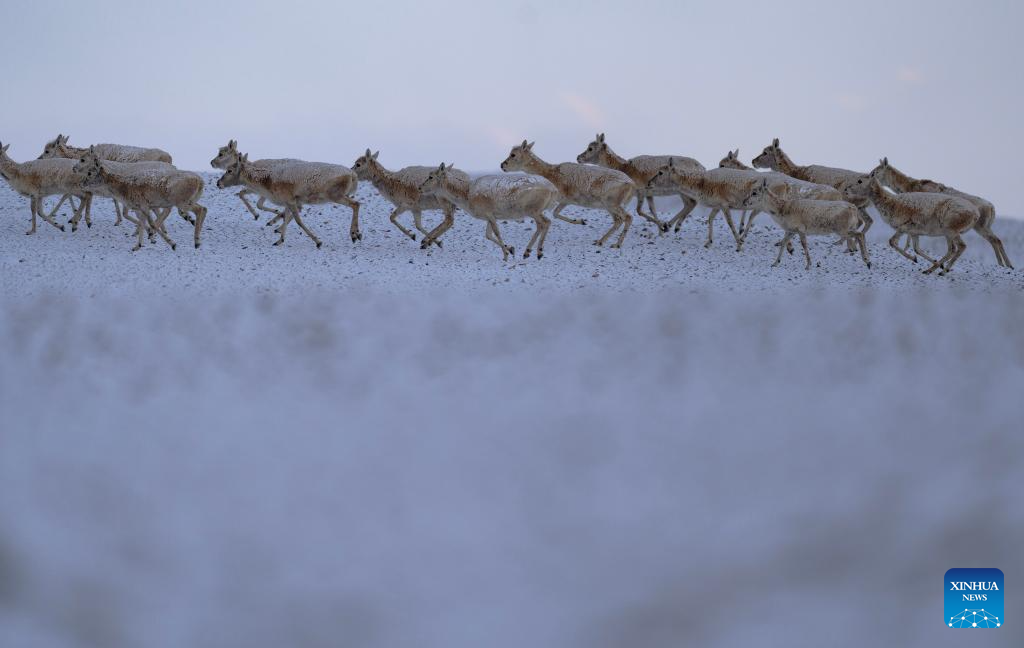
Female Tibetan antelopes are on migration to their birth-giving ground in Qiangtang National Nature Reserve in southwest China's Xizang Autonomous Region, June 15, 2024.
Tens of thousands of pregnant Tibetan antelopes start their migration around May every year for birth-giving and would return with their calves in late July. Their natural enemies including wolves and bears are always there to ambush them.
Under first-class state protection in China, the once-endangered Tibetan antelope is mostly found in the Xizang Autonomous Region, Qinghai Province, and the Xinjiang Uygur Autonomous Region. Their population has increased over the past three decades thanks to a ban on illegal hunting and measures implemented to improve their habitat. (Xinhua/Fei Maohua)

An aerial drone photo taken on June 13, 2024 shows Tibetan antelopes on migration to their birth-giving ground in Qiangtang National Nature Reserve in southwest China's Xizang Autonomous Region.
Tens of thousands of pregnant Tibetan antelopes start their migration around May every year for birth-giving and would return with their calves in late July. Their natural enemies including wolves and bears are always there to ambush them.
Under first-class state protection in China, the once-endangered Tibetan antelope is mostly found in the Xizang Autonomous Region, Qinghai Province, and the Xinjiang Uygur Autonomous Region. Their population has increased over the past three decades thanks to a ban on illegal hunting and measures implemented to improve their habitat. (Xinhua/Jigme Dorje)

Tibetan antelopes are on migration in Qiangtang National Nature Reserve in southwest China's Xizang Autonomous Region, May 8, 2024.
Tens of thousands of pregnant Tibetan antelopes start their migration around May every year for birth-giving and would return with their calves in late July. Their natural enemies including wolves and bears are always there to ambush them.
Under first-class state protection in China, the once-endangered Tibetan antelope is mostly found in the Xizang Autonomous Region, Qinghai Province, and the Xinjiang Uygur Autonomous Region. Their population has increased over the past three decades thanks to a ban on illegal hunting and measures implemented to improve their habitat. (Xinhua/Tenzin Nyida)
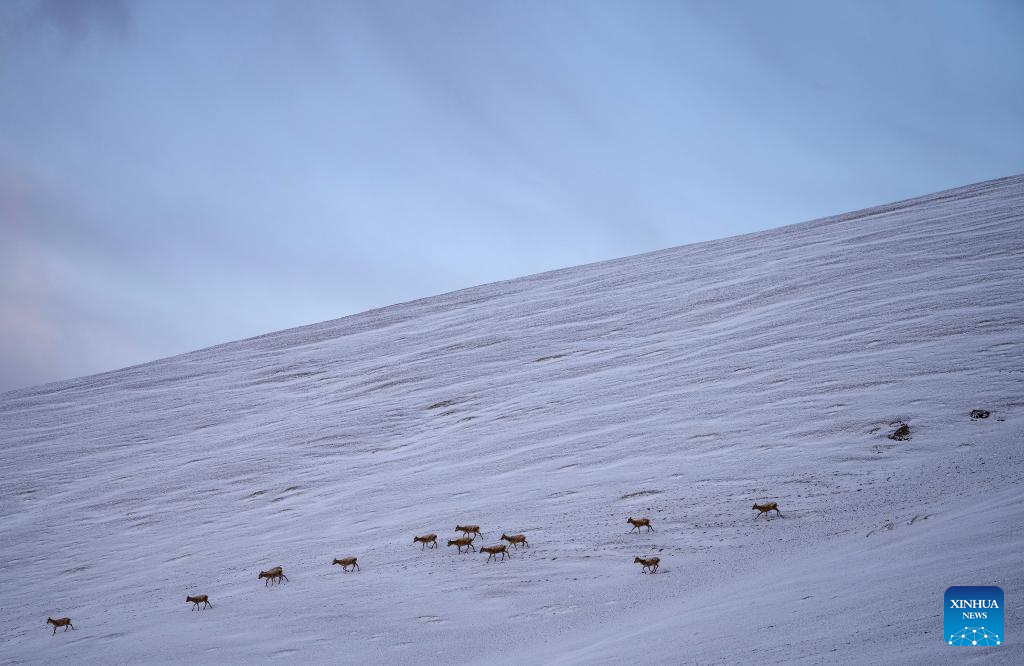
Tibetan antelopes are on migration in Qiangtang National Nature Reserve in southwest China's Xizang Autonomous Region, June 15, 2024.
Tens of thousands of pregnant Tibetan antelopes start their migration around May every year for birth-giving and would return with their calves in late July. Their natural enemies including wolves and bears are always there to ambush them.
Under first-class state protection in China, the once-endangered Tibetan antelope is mostly found in the Xizang Autonomous Region, Qinghai Province, and the Xinjiang Uygur Autonomous Region. Their population has increased over the past three decades thanks to a ban on illegal hunting and measures implemented to improve their habitat. (Xinhua/Fei Maohua)
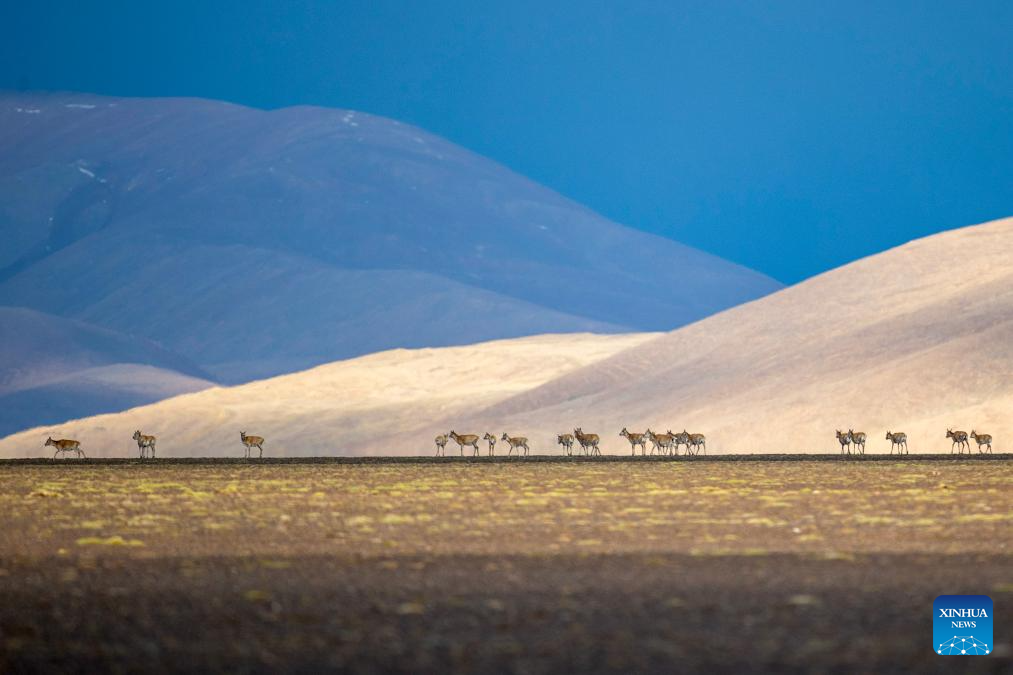
Female Tibetan antelopes are on migration to their birth-giving ground in Qiangtang National Nature Reserve in southwest China's Xizang Autonomous Region, June 13, 2024.
Tens of thousands of pregnant Tibetan antelopes start their migration around May every year for birth-giving and would return with their calves in late July. Their natural enemies including wolves and bears are always there to ambush them.
Under first-class state protection in China, the once-endangered Tibetan antelope is mostly found in the Xizang Autonomous Region, Qinghai Province, and the Xinjiang Uygur Autonomous Region. Their population has increased over the past three decades thanks to a ban on illegal hunting and measures implemented to improve their habitat. (Xinhua/Jiang Fan)
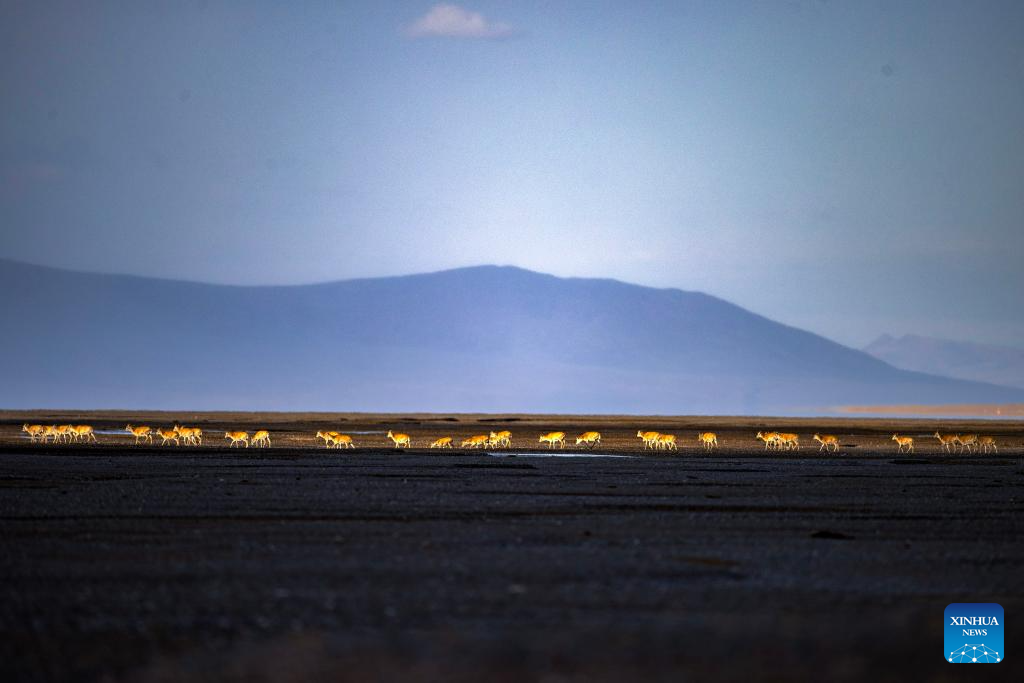
Tibetan antelopes are on migration in twilight in Qiangtang National Nature Reserve in southwest China's Xizang Autonomous Region, June 13, 2024.
Tens of thousands of pregnant Tibetan antelopes start their migration around May every year for birth-giving and would return with their calves in late July. Their natural enemies including wolves and bears are always there to ambush them.
Under first-class state protection in China, the once-endangered Tibetan antelope is mostly found in the Xizang Autonomous Region, Qinghai Province, and the Xinjiang Uygur Autonomous Region. Their population has increased over the past three decades thanks to a ban on illegal hunting and measures implemented to improve their habitat. (Xinhua/Jiang Fan)
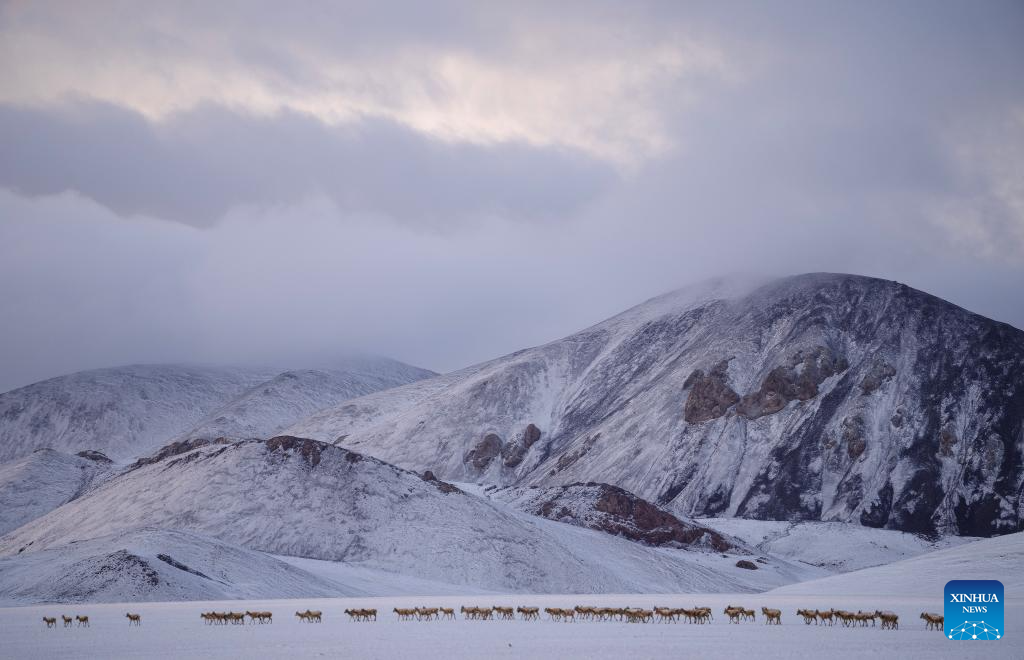
Female Tibetan antelopes are on migration to their birth-giving ground in Qiangtang National Nature Reserve in southwest China's Xizang Autonomous Region, June 15, 2024.
Tens of thousands of pregnant Tibetan antelopes start their migration around May every year for birth-giving and would return with their calves in late July. Their natural enemies including wolves and bears are always there to ambush them.
Under first-class state protection in China, the once-endangered Tibetan antelope is mostly found in the Xizang Autonomous Region, Qinghai Province, and the Xinjiang Uygur Autonomous Region. Their population has increased over the past three decades thanks to a ban on illegal hunting and measures implemented to improve their habitat. (Xinhua/Fei Maohua)

Tibetan antelopes are on migration at sunrise in Qiangtang National Nature Reserve in southwest China's Xizang Autonomous Region, June 15, 2024.
Tens of thousands of pregnant Tibetan antelopes start their migration around May every year for birth-giving and would return with their calves in late July. Their natural enemies including wolves and bears are always there to ambush them.
Under first-class state protection in China, the once-endangered Tibetan antelope is mostly found in the Xizang Autonomous Region, Qinghai Province, and the Xinjiang Uygur Autonomous Region. Their population has increased over the past three decades thanks to a ban on illegal hunting and measures implemented to improve their habitat. (Xinhua/Fei Maohua)
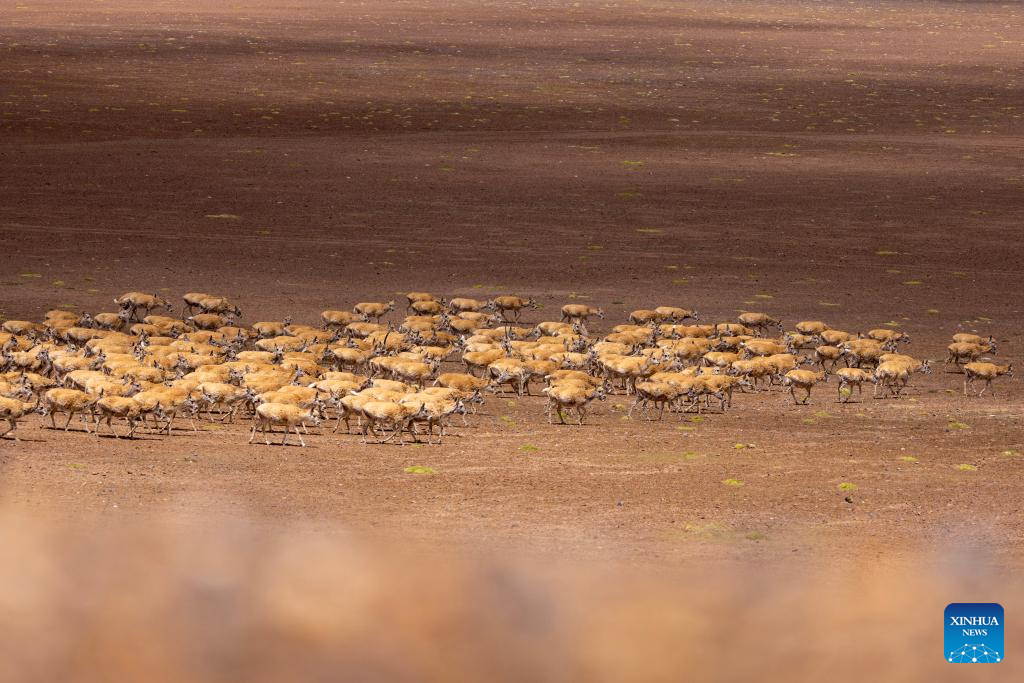
Tibetan antelopes are on migration to their birth-giving ground in Qiangtang National Nature Reserve in southwest China's Xizang Autonomous Region, June 14, 2024.
Tens of thousands of pregnant Tibetan antelopes start their migration around May every year for birth-giving and would return with their calves in late July. Their natural enemies including wolves and bears are always there to ambush them.
Under first-class state protection in China, the once-endangered Tibetan antelope is mostly found in the Xizang Autonomous Region, Qinghai Province, and the Xinjiang Uygur Autonomous Region. Their population has increased over the past three decades thanks to a ban on illegal hunting and measures implemented to improve their habitat. (Xinhua/Jiang Fan)

Female Tibetan antelopes are on migration to their birth-giving ground in Qiangtang National Nature Reserve in southwest China's Xizang Autonomous Region, June 15, 2024.
Tens of thousands of pregnant Tibetan antelopes start their migration around May every year for birth-giving and would return with their calves in late July. Their natural enemies including wolves and bears are always there to ambush them.
Under first-class state protection in China, the once-endangered Tibetan antelope is mostly found in the Xizang Autonomous Region, Qinghai Province, and the Xinjiang Uygur Autonomous Region. Their population has increased over the past three decades thanks to a ban on illegal hunting and measures implemented to improve their habitat. (Xinhua/Jiang Fan)
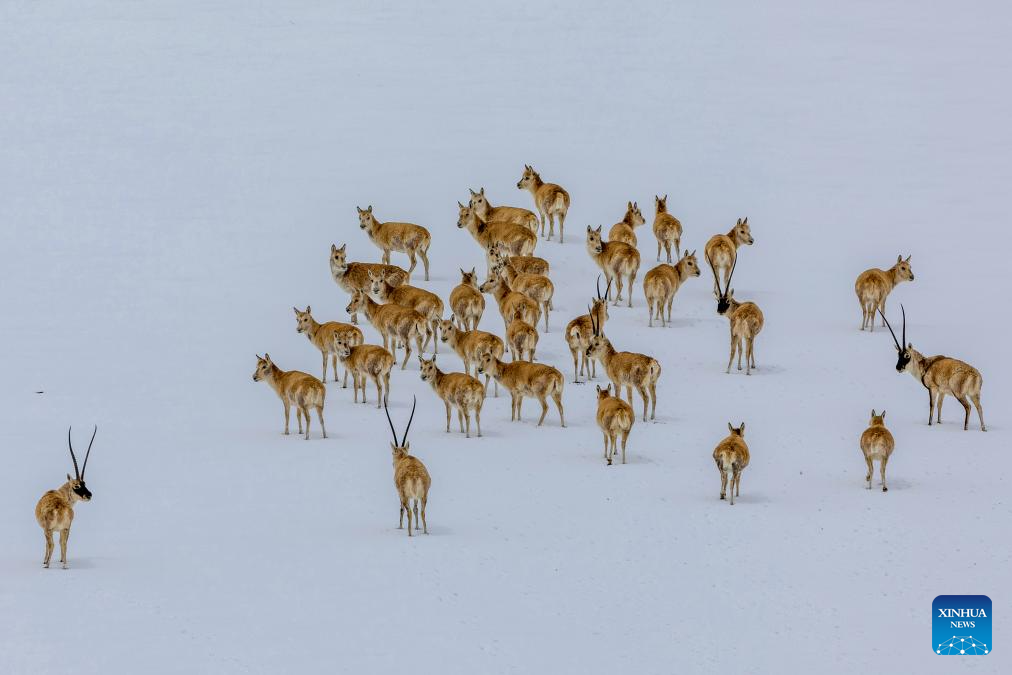
Male Tibetan antelopes guard the female ones during their migration to their birth-giving ground in Qiangtang National Nature Reserve in southwest China's Xizang Autonomous Region, May 8, 2024.
Tens of thousands of pregnant Tibetan antelopes start their migration around May every year for birth-giving and would return with their calves in late July. Their natural enemies including wolves and bears are always there to ambush them.
Under first-class state protection in China, the once-endangered Tibetan antelope is mostly found in the Xizang Autonomous Region, Qinghai Province, and the Xinjiang Uygur Autonomous Region. Their population has increased over the past three decades thanks to a ban on illegal hunting and measures implemented to improve their habitat. (Xinhua/Jiang Fan)
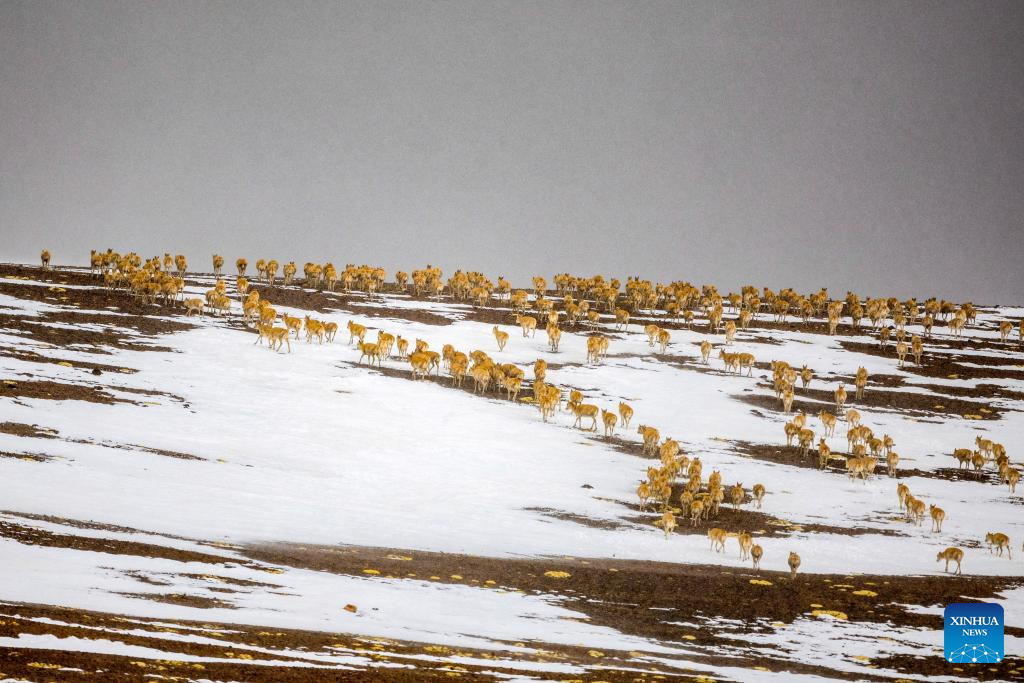
Tibetan antelopes climb over the ridge during their migration in Qiangtang National Nature Reserve in southwest China's Xizang Autonomous Region, May 10, 2024.
Tens of thousands of pregnant Tibetan antelopes start their migration around May every year for birth-giving and would return with their calves in late July. Their natural enemies including wolves and bears are always there to ambush them.
Under first-class state protection in China, the once-endangered Tibetan antelope is mostly found in the Xizang Autonomous Region, Qinghai Province, and the Xinjiang Uygur Autonomous Region. Their population has increased over the past three decades thanks to a ban on illegal hunting and measures implemented to improve their habitat. (Xinhua/Jiang Fan)

An aerial drone photo taken on June 12, 2024 shows female Tibetan antelopes on migration to their birth-giving ground in Qiangtang National Nature Reserve in southwest China's Xizang Autonomous Region.
Tens of thousands of pregnant Tibetan antelopes start their migration around May every year for birth-giving and would return with their calves in late July. Their natural enemies including wolves and bears are always there to ambush them.
Under first-class state protection in China, the once-endangered Tibetan antelope is mostly found in the Xizang Autonomous Region, Qinghai Province, and the Xinjiang Uygur Autonomous Region. Their population has increased over the past three decades thanks to a ban on illegal hunting and measures implemented to improve their habitat. (Xinhua/Jiang Fan)
点击右上角![]() 微信好友
微信好友
 朋友圈
朋友圈

请使用浏览器分享功能进行分享
